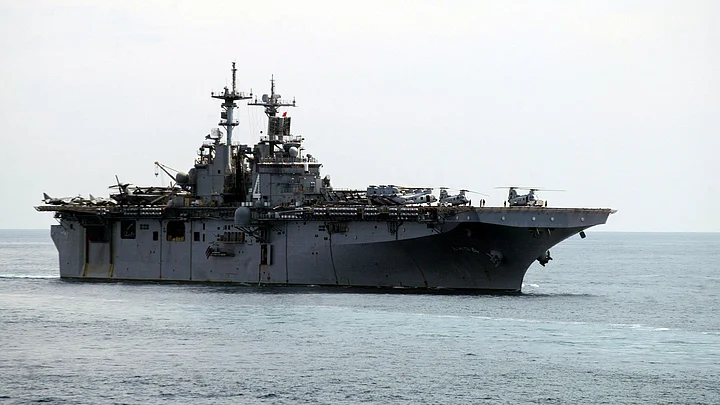Exercise Malabar
- The latest Exercise Malabar will take place from October 14 to 19
- It is one of the most advanced international naval exercises conducted by India and US
- Malabar has become a high point of Indo-US defence cooperation at the operational level
- Japan joining the ongoing exercise signals a new phase in the saga
In the early 1990s, our entry into the liberalised and globalised world also witnessed a quantum jump in the arena of maritime cooperation between US and India. A very modest beginning was made off the coast of Goa when an exercise code-named ‘Malabar’ was conducted in 1992. Not even General Kicklighter — who as Commander-in-Chief (C-in-C) US Army Pacific Command, brought along a series of proposals to institutionalise cooperation among all wings of the two militaries — would have expected Exercise Malabar to sustain and grow in the manner it has. It would be fair to state that arrangements to institutionalise this effort to promote constructive maritime cooperation have now come of age.
Given that the Indian Navy now operates with navies of Brazil, France, Oman, Russia, Singapore, Sri Lanka, South Africa, UK, and recently with Japan and Australia, it would be instructive to analyse the progress made in Exercise Malabar, the latest of which will take place from October 14 to 19.
A realistic assessment would indicate that Exercise Malabar has progressed into one of the most advanced international naval exercises conducted by India and US. In this, some analysts who have projected the current exercise, in the Bay of Bengal, as a ‘slump’ in relation to the high of Modi-Obama agreements are off the mark. Malabar has, in fact, become a high point of Indo-US defence cooperation at the operational level, and with high strategic significance. The fact that advanced operational manoeuvres are being regularly undertaken by the participating ships, aircraft and submarines (which changes every year), is indicative of the high degree of inter-operability that has been achieved between the two navies.
The Chinese objections to multilateral exercises, as opposed to bilateral ones, may be seen in this perspective. The 2005 and 2007 ones reflect the strategic dimensions of Malabar. The year 2005 saw Carriers of both navies operating together for the first time. In 2007, there were two sessions of Malabar. The first, off the coast of Japan, where India, US and Japan participated. The second in the Bay of Bengal, when Australia and Singapore joined as well. There were as many as three Carriers, a total of 26 ships and a number of shore-based strike aircraft. Given the nascent stages of Carrier operations of the Chinese Navy, which was focused on training and learning basic flying operations at sea, a display of Carrier and Anti-Submarine Warfare operations of an advanced nature between the leading navies in the region, probably unnerved China, prompting it to seek explanations.
Almost in response to the Chinese, both India and Australia, pulled out of a suggested Quadrilateral Security Dialogue with US and Japan, citing political and economic considerations respectively. The Chinese had achieved their aim in round one.
Japan joining the ongoing exercise, signals a new phase in the saga. The Modi-Obama and the Modi-Abe relations have played a significant role in deciding the approach to the Chinese hullabaloo. The declining China-Japan relations with Xi and Abe in power, the Chinese aggressive thrust in the disputed waters of South China Sea, which openly challenges freedom of navigation agreed to by the signatories of UNCLOS (The United Nations Convention on the Law of the Sea) and the all-weather relations between China and Pakistan resulting in nuclear and maritime cooperation, not forgetting the evolving silk route through a disputed territory, are factors that cannot be overlooked.
Some experts have commented on a perceived dilution of intensity in Exercise Malabar, asking why India’s Carrier could not be made available and why it cannot commit more ships. Firstly, it is important to understand that it is not the numbers but the contents that define the quality of exercises. The exercise schedule and operational canvas of Malabar 2015 are at a multi-dimensional level, consistent with the higher standards developed over the past decade.
Second, the participation of Japan, albeit with one ship, is operationally and strategically significant. And, third, the participation of Maritime Reconnaissance and Anti-Submarine Warfare aircraft in recent years, including the TU-142 and now P8I from India, and P3C by US, indicate the wide range of operational scenarios being exercised.
With reference to the Carrier debate, the US Navy is a vast force with 10 large and nine medium-sized Aircraft Carriers, which regularly deploy to various parts of the globe. On the other hand, India, which plans to have a three-carrier task force in the future, currently operates two medium/small-size Carriers, with Viraat to be retired shortly. Vikramaditya, the primary Carrier, has to complete its scheduled maintenance and operational consolidation with the fleet in the Arabian Sea, before deployment to the Bay of Bengal for the forthcoming International Fleet Review. Hence, the inclusion of an Indian Carrier for Malabar cannot be done merely on theoretical considerations.
However, what stands out is that Malabar has become a regular and key feature of Indo-US maritime cooperation, with a high degree of operational gains and levels of inter-operability achieved.
What has gone unnoticed in the profile of the Indian Navy is that the Eastern Fleet which is tasked to operate across the Malacca straits has been bolstered with new induction ships, which is in keeping with our political objective of ‘Look East’ policy.
While political blips may appear from time to time on the radar scan, it would be wise to view them over a historical time frame rather than year-on-year.
(The writer is a former Commander-in-Chief, Southern Naval Command.)
